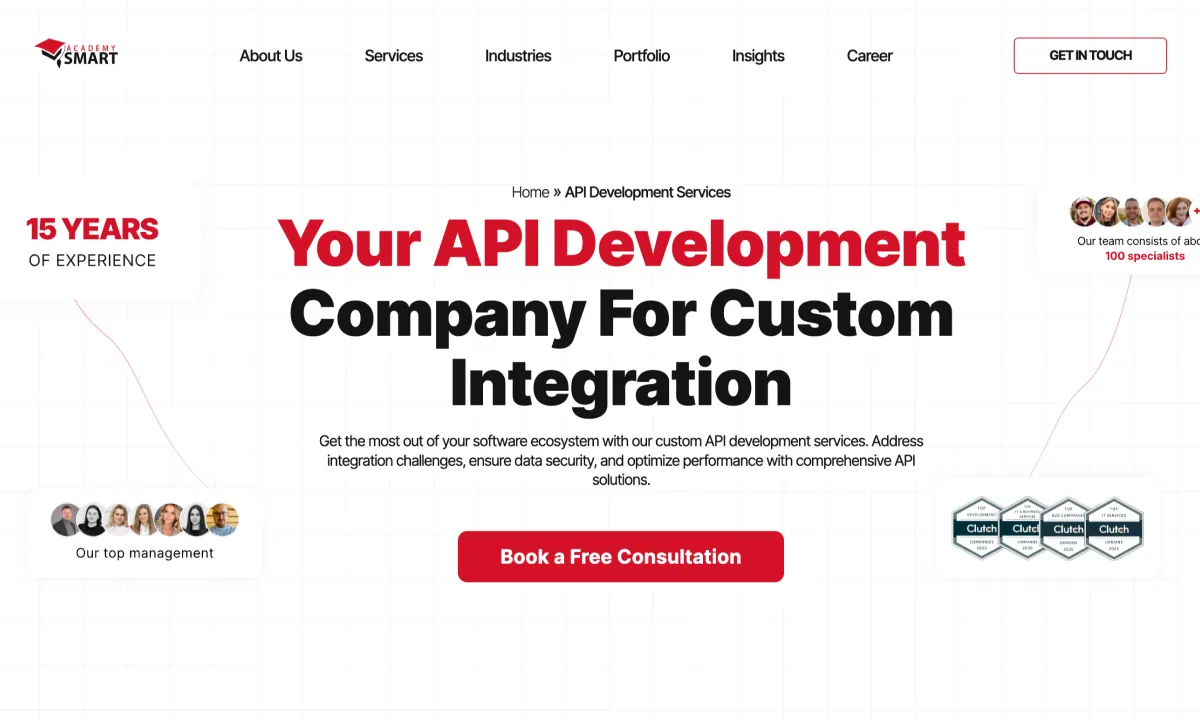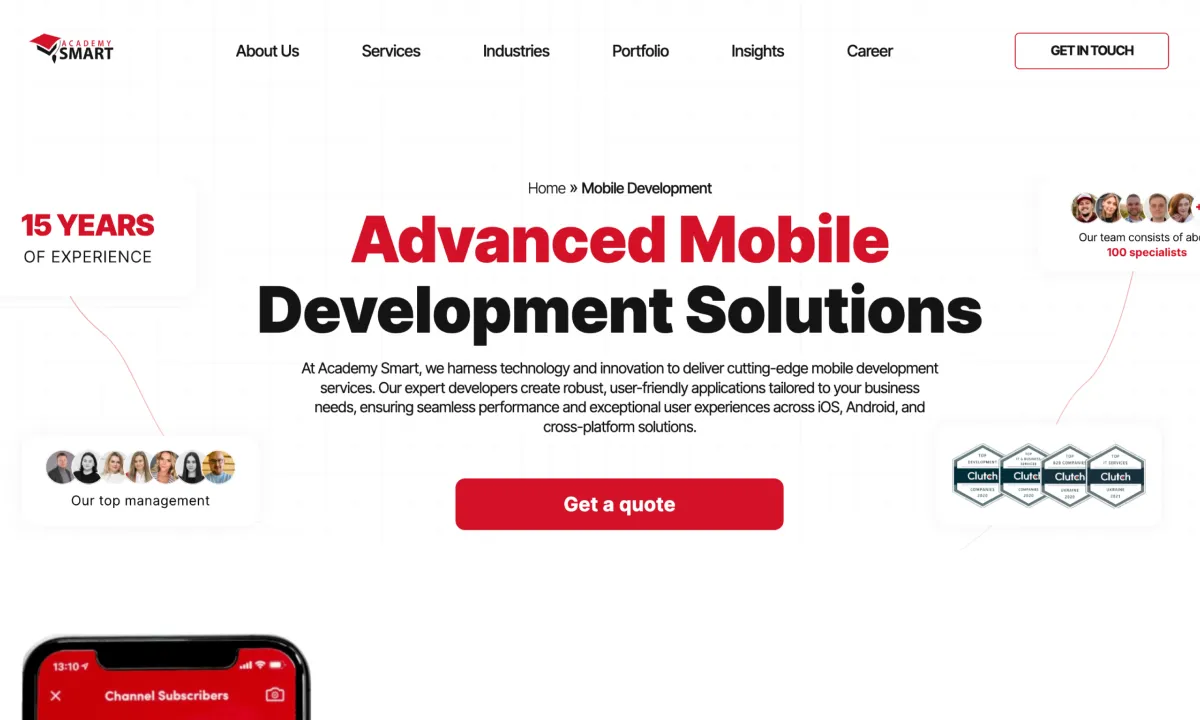
How to build a Healthcare App in 2023: complete guide
Contents
The healthcare industry has witnessed a surge in digital transformation, and the demand for appropriate software is constantly rising. With the advancements in technology, building special medical applications has become more accessible than ever before. On the other hand, the experience of quarantine restrictions during the Covid-19 pandemic required new and more efficient solutions for organizing remote patient care.
According to a report by ResearchAndMarkets, the global mobile medical software market is expected to reach $111.1 billion by 2025, growing at a compound annual growth rate of 38.8% from 2020 to 2025. It is driven by increasing healthcare costs, the rising prevalence of chronic diseases, and the growing adoption of smartphones and other wearable devices. Moreover, the market is also becoming more competitive. Right now, more than 110 thousand different medical applications are available. So, developing a modern healthcare app requires careful planning, execution, and ongoing maintenance.
This article will explain how to create a demand medical app in 2023. By following this guide, you can ensure that your healthcare software meets your target audience’s wishes.
What is a Healthcare App
A medical app is a software application designed specifically for the healthcare industry to improve patient care and experience. It is a digital platform allowing patients to access medical services, track their health data, and communicate with healthcare providers. Healthcare software are highly versatile and can serve different functions, such as appointment scheduling, medication tracking, and chronic disease management. The app can be accessed through various devices, including smartphones, tablets, and wearables, making healthcare more accessible and convenient for patients.
Developing a modern medical application is a challenging task. Especially given the industry’s high competition and the market saturation with various solutions for different purposes. Therefore, a well-defined roadmap in the case of health app development is of particular importance, helping to ensure that the project’s scope is correctly sized, the allocation of resources is efficient, and the timeline is realistic and achievable.
Types of Medical Applications
Healthcare apps have become increasingly popular and widespread, providing various benefits for patients, medical professionals, and healthcare organizations. Different types of medical software are designed to address specific needs, from tracking health metrics to providing access to telemedicine services. Each type of healthcare app built today has unique features, challenges, and profits. Below, we will explore different types of existing applications, their purpose, and how they contribute to improving healthcare services.
Healthcare Apps for patients
Apps for patients provide users with various tools and resources to help manage their health and wellness. From tracking medications and symptoms to finding nearby healthcare providers, these apps offer convenient and accessible solutions to most healthcare needs. The most common list of such health applications typically includes:
- Applications for self-diagnosis
This type is designed to help users identify their symptoms and receive recommendations on managing them. The self-diagnosis apps use various algorithms and medical knowledge databases to suggest the possible causes of the symptoms and recommend treatment options and preventive measures. While these apps are not intended to replace a doctor’s opinion, they can be a helpful tool in managing a user’s health and well-being. - Lifestyle tracking apps
Lifestyle tracking applications help individuals monitor and track various aspects of their daily lives, including diet, exercise, sleep, and stress levels. These apps can provide users with personalized insights and recommendations to help them make healthier choices and achieve their wellness goals. Some lifestyle tracking apps can integrate with wearable or IoT devices, such as fitness trackers, scales or smartwatches, to collect data automatically and provide more accurate tracking and analysis. These apps can be handy for individuals looking to adopt healthier habits, manage chronic conditions, or maintain a healthier lifestyle. - Women’s health applications
These software programs exist to help women monitor their health, including reproductive health, menstrual cycles, pregnancy, and menopause. Some women’s health apps include exercise tracking, nutrition tracking, and stress management tools. These applications can be helpful for women who want to take an active role in managing their health and wellness. - Diet apps
Diet apps focus on helping users manage their nutrition and eating habits. These apps provide features such as calorie tracking, meal planning, and nutritional food information. Some diet applications may also include components for tracking exercise and physical activity and offering customized diet plans based on personal preferences and goals. These apps aim to help users make healthier food choices and develop sustainable eating habits to achieve their fitness goals. - Fitness apps
Fitness applications are created to help users improve their physical fitness and overall health. With the growing popularity of a healthy lifestyle, numerous fitness apps are available in the market, catering to various fitness goals and levels, from beginner to advanced. This software typically provides a variety of features and functionalities, such as workout tracking, personalized exercise plans, calorie and nutrition tracking, and social networking to connect with other fitness enthusiasts. Some of them also offer virtual coaching and training sessions, allowing users to access professional advice and support from their homes. - Reminder apps
Medical reminder apps exist to help patients keep track of their medication schedules and other health-related tasks. This software often comes with a user-friendly interface that makes it easy to set reminders for various tasks, such as taking medication, scheduling appointments with doctors, and monitoring vital signs. Some medical reminder apps also allow users to track their symptoms, which can be useful in helping patients manage chronic conditions. - Apps for medical education
This type exists to provide easily accessible, accurate, and reliable medical information to patients. Using this software, they can become more informed and empowered in managing their health. They usually include interactive learning tools, videos, diagrams, and other resources to help patients better understand their health and medical conditions. Healthcare professionals create some education apps, while others are built by reputable organizations specializing in specific medical conditions. - Mutual support social networks
It is a platform for patients with chronic conditions or rare diseases to connect and support one another. It allows people to share experiences, provide emotional support, and exchange information about treatments and coping strategies. These apps also often include forums or chat rooms where patients can ask questions and get answers from others who are going through similar experiences. By fostering a sense of community and connectedness, mutual support social networks can help patients feel less isolated and better equipped to defeat their disease.
Medical App for doctors and medical institutions
There are also healthcare apps created to streamline and optimize the workflows of doctors and medical institutions, providing a comprehensive platform for efficient patient management, diagnosis, and treatment. You may find among them the following:
- Appointment with a doctor apps
These digital platforms enable patients to schedule appointments with healthcare providers using their mobile devices or computers, including doctors, nurses, and other medical professionals. They typically allow patients to search for doctors based on specialty, location, availability, and other parameters and book appointments in real-time or beforehand. Some apps also provide additional features such as reminders, online consultations, prescription refills, and health tracking. - Remote patient monitoring apps
These apps allow healthcare providers to remotely monitor the health status of patients using various technologies such as wearables, mobile devices, and sensors. They enable patients to track their vital signs and symptoms, and share this information with their doctors in real time. Healthcare providers can then use this data to identify potential health issues early on, and adjust treatment plans as needed. Remote monitoring apps benefit patients with chronic conditions, those recovering from surgery, and those requiring ongoing medical attention. - Telemedicine applications
This software allows patients to connect with healthcare providers through video, audio, or text-based communication. Telemedicine applications can be used for various medical needs, including routine check-ups, follow-up appointments, mental health consultations, and prescription refills. Some of them also provide remote monitoring services, where patients can track their vital signs and share this information. They can also reduce healthcare costs by eliminating the need for in-person visits and reducing hospital readmissions. - Diagnostic applications
Diagnostic applications aim to improve the accuracy and efficiency of medical diagnoses, reduce diagnostic errors, and improve patient outcomes by enabling healthcare providers to make informed decisions about patient care. They use artificial intelligence and machine learning algorithms to help diagnose and treat medical conditions. This software can analyze medical images, lab results, and other data to identify patterns and indicators of illness. - Prescription management apps
This type aims to improve medication adherence, reduce medication errors, and give patients more control over their healthcare. These applications allow patients to store their medication information in one place, including dosage, frequency, and other relevant details. Patients can receive reminders to take their medications at the right time and track their progress over time. Prescription management apps can also facilitate communication between patients and their healthcare providers, allowing patients to request prescription refills and ask questions. Some prescription management apps also provide information on drug interactions, side effects, and other important information. - Applications of Electronic Medical Records
Electronic Medical Records (EMR) software is a digital platform that enables healthcare providers to store, manage, and share patient health information electronically. EMR applications can include various features, such as patient demographics, medical history, lab results, prescription information, and other critical clinical data. EMR apps can be accessed by authorized healthcare providers in real-time, allowing for improved collaboration and communication among healthcare teams. Some EMR applications also provide decision support, alerting healthcare providers to potential drug interactions, allergies, and other relevant patient information. They can also help to streamline administrative tasks, such as billing and insurance claims processing, leading to cost savings for medical institutions. - Medical reference applications
They provide healthcare professionals and students with access to medical reference materials, including textbooks, journals, drug references, and clinical practice guidelines. Medical reference apps can be accessed on mobile devices or computers, allowing users to search for clinical research information quickly and conveniently. - Professional networks
Medical networks are digital platforms that connect healthcare professionals, enabling them to collaborate, share knowledge, and access resources. These apps can be accessed through any device, allowing users to connect and communicate with colleagues from anywhere. Some medical professional networks also provide job search and career development resources, allowing users to explore career opportunities and expand their professional connections.
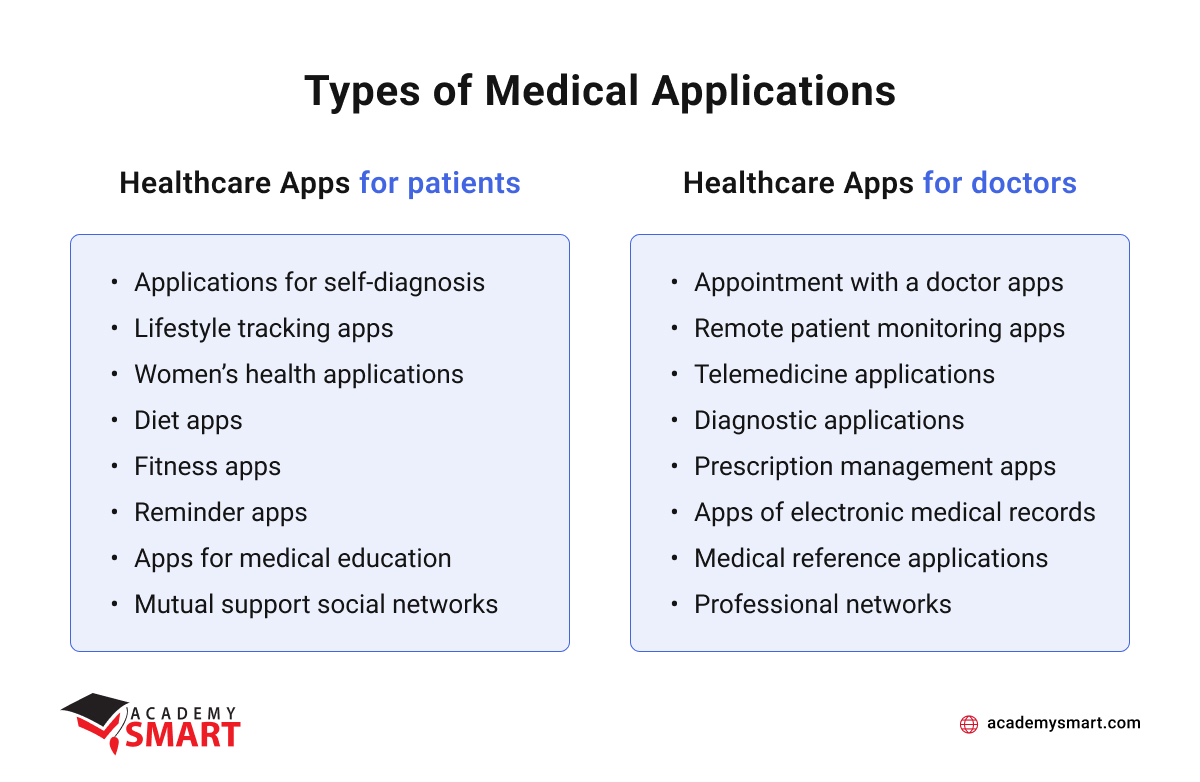
Typical healthcare apps you may find on market
TOP-5 most popular Healthcare App
The digital solutions market for healthcare is oversaturated with various applications catering to different needs, so any listing of the popular medical apps will be more or less subjective. Nonetheless, it is beneficial for developers to be familiar with the examples of top-performing healthcare apps:
- Analyzing the most in-demand apps can provide insights into what features attract and retain users.
- Examining the technologies used in successful apps can inform new software development.
- It allows developers to explore the new possible value and add innovative features to the niche by leveraging modern programming languages and technical tools.
MyChart
MyChart is an online platform that provides patients with secure access to personalized medical records. It allows individuals to manage and safely receive information about their health online. It enables patients to schedule medical appointments, view a health summary, access trusted health information resources, renew prescriptions, and communicate electronically with their medical team from their homes.
GoodRx
GoodRx is an online platform offering a free website and mobile app. It keeps track of prescription drug prices in the United States and provides coupons for medication discounts. GoodRx checks more than 75,000 pharmacies nationwide, so customers may save up to 80% on their prescription drugs by using this app.
Headspace
Headspace is a mindfulness app that aims to improve users’ mental health and sleep patterns. It offers hundreds of guided meditations on stress and anxiety management, productivity, exercise, and physical health, with the option to choose from short SOS meditations for on-the-go use.
Visible Body
Visible Body is a renowned producer of educational software and apps widely used by over a million healthcare professionals, educators, and students across the globe. Its interactive and engaging approach to studying anatomy and biology makes learning faster and easier through 3D visuals, micro-lessons, and game-like interactivity.
Medscape
Medscape is a web-based application that offers clinicians access to medical information and provides continuing education for physicians and health professionals. It offers medical journal articles, continuing medical education, a version of the National Library of Medicine’s MEDLINE database, medical news, and drug information through its Medscape drug reference.
Academy Smart also has a solid track record of building specialized healthcare applications, which can be found in our portfolio.
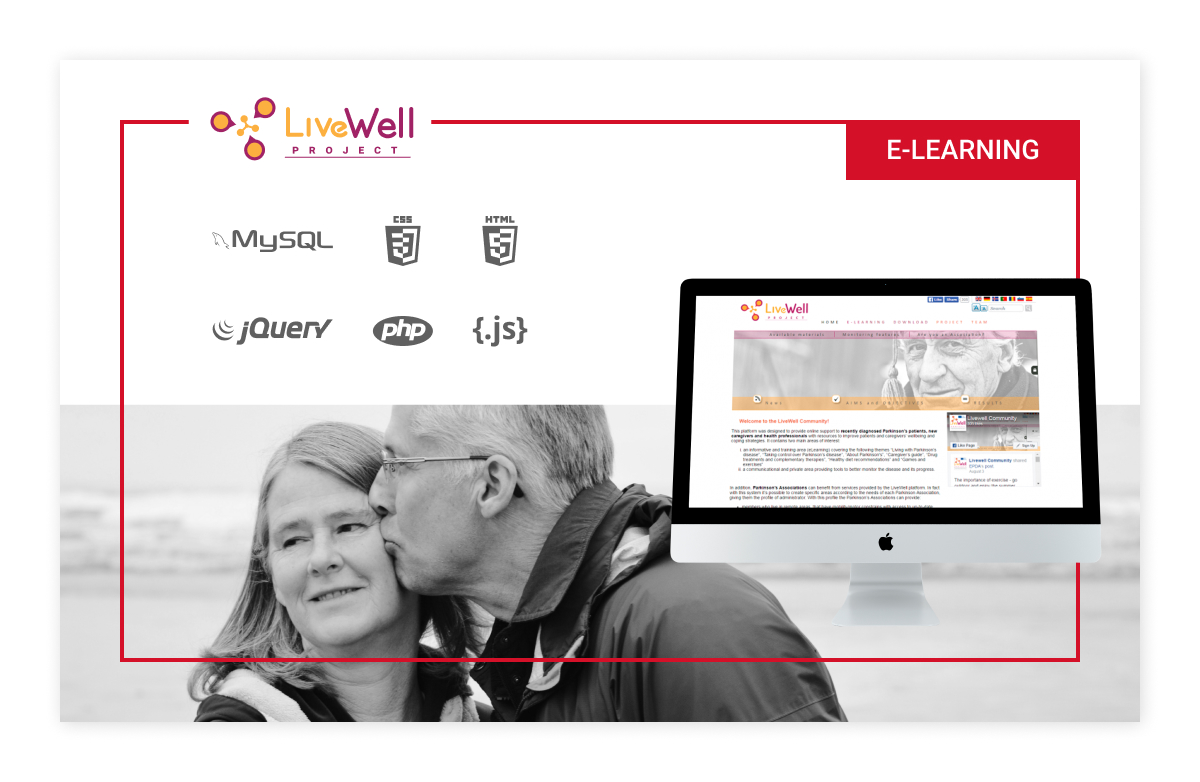
E-learning platform for patients our team delivered
Benefits of Healthcare App
Medical software can offer a range of advantages, such as improved patient outcomes, increased efficiency in healthcare delivery, and enhanced patient engagement. To fully realize these benefits, it is essential to understand how to make a medical app that is effective, user-friendly, and scalable. In this context, exploring them can help healthcare providers and developers design applications that meet the needs of all stakeholders in the healthcare sphere.
Immediate accessibility
Healthcare apps can be accessed by patients and healthcare providers at any time and from anywhere, as long as they have an internet connection. It means that patients get healthcare services without having to physically visit a healthcare facility, saving them time and reducing the need for transportation. For medical institutions, immediate accessibility means they can quickly access patient information, communicate with colleagues, and make informed decisions about patient care, even outside traditional healthcare settings.
Improved data management and safety
It is another essential advantage of healthcare apps. Medical apps can store patient health information in a secure and centralized digital location, making it easier for healthcare providers to manage patient data and ensure its accuracy. With their help, healthcare providers can access and update patient data in real-time, enabling them to make informed decisions and avoid duplication of tests and procedures. Healthcare software can also improve data safety, using advanced encryption technologies and other security features to protect patient data from unauthorized access, hacking, and other security threats.
In addition, healthcare apps can help healthcare providers comply with regulatory requirements for data management and security, reducing the risk of legal and financial penalties. Overall, improved data management improves healthcare delivery efficiency and reduces costs.
Ease of communication
Healthcare apps can facilitate communication among healthcare providers, patients, and caregivers, allowing them to share information, ask questions, and provide updates quickly and conveniently. It can lead to better patient outcomes and increased patient satisfaction. For healthcare providers, medical software provides collaboration and communication across different departments and specialties, enabling them to coordinate patient care more effectively. Patients can access educational materials, resources, and support groups, allowing them to manage their health more consciously and improve their quality of life.
High scalability
High scalability is an essential advantage of medical applications, ensuring their effectiveness and widespread adoption. These apps handle many users and data without compromising performance or functionality. It is crucial to use modern technology platforms and design the application with scalability in mind to develop a perfect medical app.
IoT integration
IoT devices like wearables and sensors can collect and transmit patient health data, enabling medicine institutions to monitor and analyze patient health more effectively. IoT integration allows patients to check their state at home and provides doctors with real-time their status data. With the help of IoT-equipped medical apps, healthcare providers can identify health problems earlier, personalize patient care, and monitor patient progress more effectively.
Automation of notifications and reports
Healthcare software automates sending notifications and reports to patients and providers, reducing the administrative burden on medical staff and improving the efficiency of service delivery. Patients can receive automated notifications for upcoming appointments, medication reminders, and test results, ensuring that they are informed and engaged in their healthcare. Healthcare providers can also receive automatic notifications for patient data, such as abnormal lab results, enabling them to take immediate action if needed.
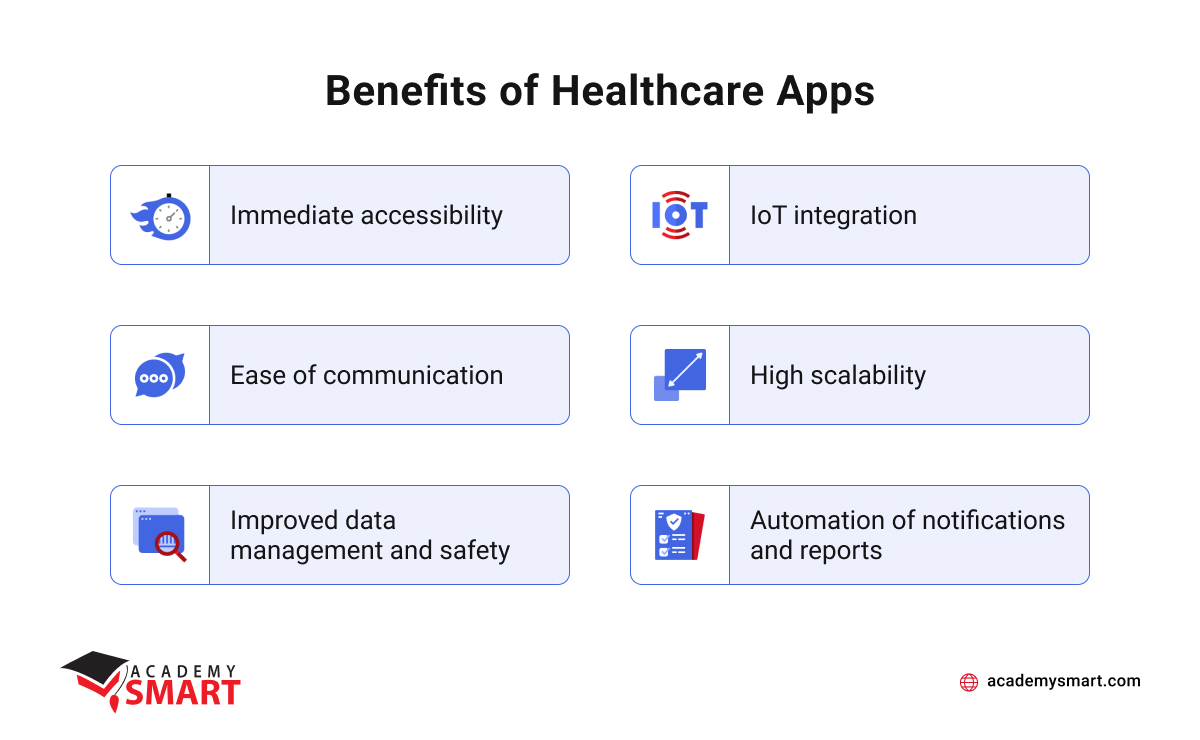
The main benefits of modern healthcare applications
Medical application development: 6 mistakes
Creating a medical app requires attention to detail and careful planning. However, even the most experienced developers can make mistakes during the process. Here, we’ll discuss some of the most common errors in healthcare application development and how to avoid them. So, if you’re wondering how to create an excellent medical app, read on to learn more.
Poor research into your market niche
Creating a product that meets their needs is impossible without a thorough understanding of the target audience. That can lead to low adoption rates, negative reviews, and a lack of revenue. It’s essential to conduct market research to identify the pain points of the target audience and their preferences for features, design, and user experience.
Cognitive complexity of user experience
A common mistake is creating an app that is too complex for the user to navigate, causing frustration and ultimately leading to the user abandoning the app. How to avoid this mistake and develop a user-friendly medical app? Developers should prioritize simplicity and ease of use to ensure a positive user experience. So, they have to conduct user testing to determine the app’s optimal design and user interface.
One-feature MVP
Creating a Minimum Viable Product (MVP) with only one feature may have costly consequences. While it may seem like a logical first step, healthcare software that provides minimal functionality can’t demonstrate all possibilities of application and attract enough users to be viable in the long run. It’s essential to create an MVP with a range of features that address the critical needs of your target audience. This approach will allow you to gather user feedback and make informed decisions about future development. Failing to create a comprehensive MVP may waste time, effort, and resources.
Choice of cheaper solutions in development
While cost is always a concern, cutting corners can lead to severe consequences regarding the quality and safety of the app. Choosing a cheaper technology stack might result in a bad user experience or security vulnerabilities, which can put sensitive health data at risk. Similarly, hiring a less experienced or cheaper development team might result in an app that lacks the necessary features or is not intuitive.
Therefore, it is important to prioritize quality and safety over cost in medical software development. It can involve investing in better technologies or hiring a more experienced development team to ensure the app meets the necessary standards and delivers the intended user experience.
Non-compliance with national industry standards
Healthcare apps deal with sensitive and confidential information, which makes adherence to industry standards critical. Failure to comply with these standards can have severe legal and ethical consequences. Researching and understanding the relevant regulations and guidelines, such as HIPAA in the United States or GDPR in the European Union, is needed to ensure that the app development process complies. It requires collaboration with legal and regulatory experts and a commitment to ongoing monitoring and updates as regulations evolve.
Monetization with annoying ads
While advertisements can generate earnings, they can also create a poor user experience and discourage users from continuing to use the app. Additionally, healthcare is a sensitive industry, and users may not appreciate being bombarded with ads for unrelated products or services. A better approach is to consider alternative monetization strategies, such as offering premium features or subscription services, which can provide value to users while generating revenue.
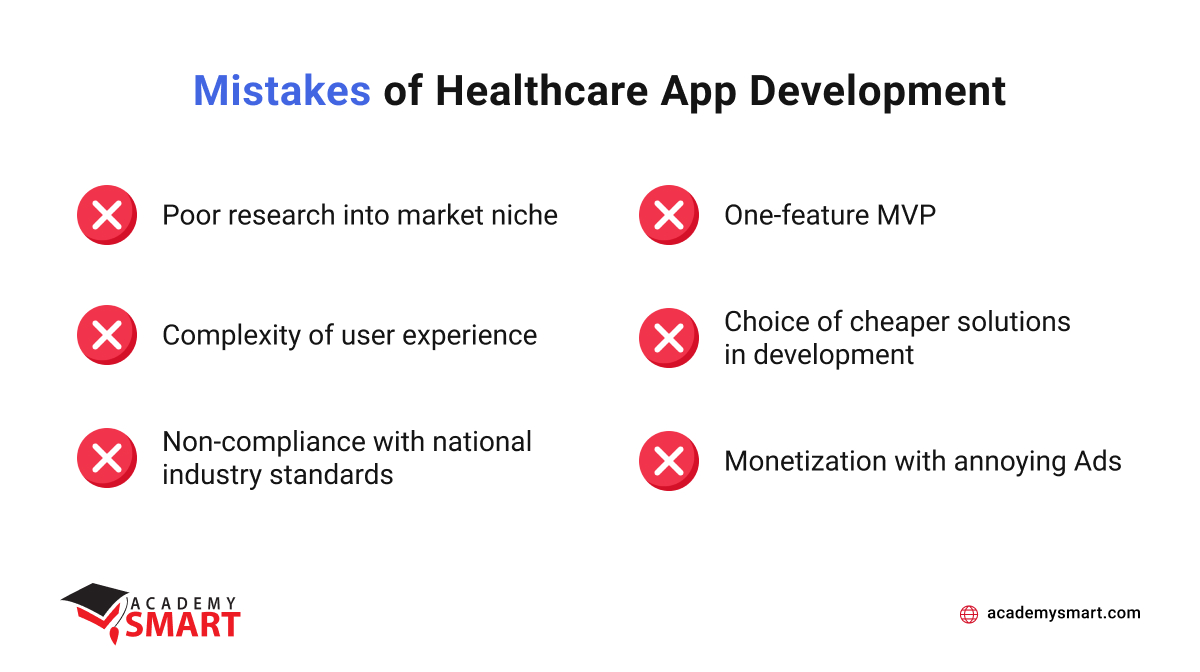
The worst mistakes in medical apps development
6 steps to build Healthcare App
Building a healthcare app is a multi-step process that requires careful planning, execution, and ongoing maintenance. These steps include identifying the problem and defining the solution, conducting market research and identifying the target audience, designing and prototyping the app, developing and launching an MVP, deploying the entire application, and providing continuous support and further development. By following them, you can be sure that your medical software meets the needs of doctors and patients, while remaining compliant with healthcare regulations and standards.
Step 1. Define the goals and value of your app
Starting development involves researching your target audience, determining the type of app you want to get, and creating a comprehensive feature list that aligns with the app’s purpose. By understanding your audience, you can make an app that delivers real value and meets the market’s demands. Additionally, identifying the type of healthcare application you want to build (such as a self-diagnosis app, a medical reminder app, or a fitness app) and the features it should have will help you plan the development process and estimate the costs involved. It also lets you choose the right technology stack to implement the application’s functions and stable operation under heavy loads. Ultimately, defining your goals and value proposition will lay a solid foundation for a successful medical app.
Step 2. Assemble your development team
Once you have defined the aims, the next step is to assemble your development team. This team should include individuals with the necessary skills and expertise to develop a high-quality healthcare app. It typically comprises a project manager, designers, developers, and quality assurance testers.
It’s important to carefully select each team member based on their experience and expertise. Consider their previous work, industry knowledge, and ability to communicate effectively. Additionally, ensure that each member is committed to the project and clearly understands the project’s goals and objectives.
Once you have assembled your team, it’s crucial to establish clear communication channels and project timelines to ensure that everyone is working towards the same goal. Regular meetings and progress updates are essential for keeping everyone on track and addressing any issues that may arise.
Step 3. Create UI/UX prototype
The following step is creating a UI/UX prototype. Creating a clickable prototype can help developers identify potential technical challenges and refine the app’s architecture. It visualizes the application’s user interface and user experience design, allowing stakeholders to understand how it will function before any code is written. It can be used to conduct user testing and gather feedback, allowing necessary adjustments to be made early in the development process.
Step 4. Develop and launch MVP
The next stage is creating and launching a Minimum Viable Product (MVP) to test the basic functionalities of the app with a group of initial users. This step is essential to determine the viability of the app in the market before investing significant resources in its further development. The MVP should be launched with limited features to gather feedback from a broader user base. The team should monitor user behavior and engagement with the app to understand how it is used and identify improvement areas for later releases.
Step 5. Deploy the full application
Releasing the fully-functional application marks the transition from the development phase to the operational phase, where the software is ready for use by healthcare professionals and patients.
Before deploying the complete application, the development team should ensure that the app meets all the requirements and standards for medical applications, such as data security and privacy regulations, interoperability with other healthcare systems, and compliance with industry standards.
The deployment process involves several stages: testing, integration, and implementation. The team should thoroughly test the application to ensure it is free from bugs, errors, and other issues that could affect its performance or user experience.
Integration involves connecting the app with other healthcare systems and technologies, such as electronic health records, medical devices, and other applications. It is essential for ensuring interoperability and seamless data exchange between different healthcare systems.
Finally, the implementation stage involves releasing the application to the target audience. It could include marketing and promotional activities to raise awareness and drive the adoption of the application. The team should also provide users with training and support to ensure they can use the application efficiently.
At last, the development team should continue to monitor its performance and user feedback. It will allow them to identify and address any issues that may arise and continuously improve the application to meet the evolving needs of the healthcare industry.
Step 6. Provide continuous support and further development of your app
Continuous support involves technical assistance, bug fixing, and user maintenance to ensure the application functions smoothly and effectively. It could include providing a help desk or customer support service where users can report issues, ask questions, or seek guidance on using the application.
Further development of the app involves adding new features and functionalities to the application to meet the changing needs of the healthcare industry. That could include identifying new requirements, the latest healthcare regulations and standards, and audience’s pain points and incorporating them into the application. The development team should also stay up-to-date with the latest healthcare technologies and trends to ensure the application remains competitive and effective.

Reliable healthcare app-building algorithm
How much does it cost to build a healthcare app
The cost of creating a medical app can vary widely depending on factors such as the complexity of the app, the features and functionality required, the platforms it will be built for, the development team’s experience and location, and other related costs like server hosting and maintenance. However, the cost to build a healthcare app ranges from tens to hundreds of thousands of dollars or more. It’s essential to consider your budget and priorities carefully and work with a reputable development team to create a realistic project estimate. To meet with nice healthcare applications delivered by the team of Academy Smart, look at our portfolio.
How Academy SMART can help you
Academy Smart offers its assistance in the development of modern healthcare applications for various purposes. Among the hundreds of projects that we have already delivered, there are several medical apps, the work on which has allowed us to gain knowledge of the specifics and requirements of the industry and invaluable experience in choosing the best solutions.
As we are an outstaffing company from Ukraine, we invite you to take advantage of the high-quality services of our programmers at an excellent Eastern European price. Our team can be helpful to you as a point of access to talented, competent, and experienced developers in various front-end and back-end areas. Contact us to voice your goals if you need qualified remote employees to expand your development staff. Together we will find a worthy solution.
How to create a Medical App: Frequently Asked Questions
How do Health Apps make money?
Health apps can generate revenue through various methods, including in-app purchases, subscription models, advertising, sponsorships, and data monetization.
What’s the Healthcare Apps market like?
The market includes various applications for fitness and wellness, medical diagnosis and treatment, patient education, and more. As the industry evolves, new opportunities for innovation and investment are likely to emerge.
Book a free consultation

Reach out to start talking today!






